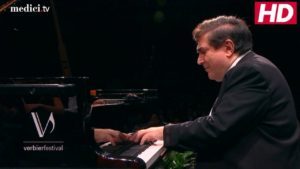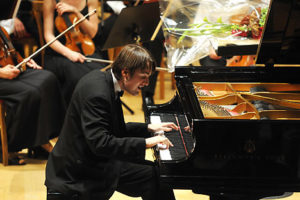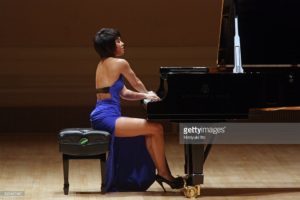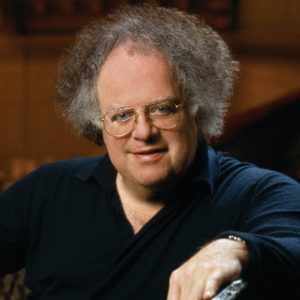Joseph Horowitz's Blog, page 26
March 15, 2018
Mieczyslaw Weinberg on Film
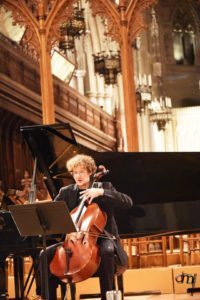 Is Mieczysław Weinberg (1919-1996) a third Soviet composer to set beside Shostakovich and Prokofiev? An increasing number of musicians seem to think so, including the peerless Latvian-born violinist Gidon Kremer, himself a product of Soviet training.
Is Mieczysław Weinberg (1919-1996) a third Soviet composer to set beside Shostakovich and Prokofiev? An increasing number of musicians seem to think so, including the peerless Latvian-born violinist Gidon Kremer, himself a product of Soviet training.
My own impressions of Weinberg’s music have been spotty and confused, the peak experience having been Ben Capps performing Weinberg’s 1968 cycle of 24 Preludes for solo cello at Washington National Cathedral earlier this season – a program presented by PostClassical Ensemble (of which Capps is principal cellist).
Weinberg’s output for cello was immense: the 24 solo Preludes, three solo sonatas, two sonatas for cello and piano, and a cello concerto. He was not a cellist – and his cello writing does not explore new possibilities for the instrument (as Benjamin Britten’s does). But the cello’s voice suits Weinberg’s dark turbulence of feeling and expression. I don’t hear a single happy note in this cycle. And certainly Weinberg’s musical embodiment of Stalinist Russia — however subliminal or explicit, conscious or incidental – is fundamental to his appeal.
Behrouz Jamali, who turns our PostClassical Ensemble concerts into films, has produced a remarkable 20-minute memento of Capps’ performance, interspersed with my own comments and observations. The result, I would say, makes a stirring case for the importance of this composer, and of this music. You will find it by clicking here.
Ben Capps will return to Washington National Cathedral (where PostClassical Ensemble is Ensemble-in-Residence) next Fall to repeat Weinberg’s 24 Preludes in honor of the Weinberg Centenary. He has also recorded the cycle – a studio performance now being edited.
Ben’s concert came at the tail end of a two-year PCE commemoration of the centenary of the Russian Revolution. He earlier participated in a program exploring Soviet experimental music of the 1920s, curated by Vladimir Feltsman. It yielded another Behrouz Jamali film.
The final events in this series are a screening of the classic 1929 Soviet silent film The New Babylon, with Shostakovich’s score performed live, on March 30-31 at the American Film Institute; and “Musical Skirmishes of the Cold War: The Shostakovich Case” at Washington National Cathedral May 23. For information: www.postclassical.com
March 4, 2018
It’s Not Over Yet: Babayan, Trifonov, Yuja Wang
At my age – I somehow just turned seventy – it’s considered normal to wax “sentimental” and yearn for better times. Nostalgia: a cliché.
But in the case of the world of classical music that I have long inhabited, there’s nothing sentimental about fond retrospection. It’s an art genre in decline. Orchestras are in decline, Singing is in decline. The piano is in decline. And – the most certain evidence of all – the repertoire is no longer being much replenished. (For some pertinent blogs in this space, click here for orchestras and here for singers; re: pianists, read on.)
And so last Thursday’s event at Carnegie’s Zankel Hall becomes a source of bewilderment. Two pianists took part. Sergei Babayan studied at the Moscow Conservatory – where, thanks in part to the Iron Curtain, traditions lingered longer. Danill Trifonov is a protégé of Sergei Babayan. At the age of 26, he has acquired a big international career without recourse to glamour or personal celebrity.
Babayan and Trifonov played three staples of the two-piano repertoire: the Mozart K. 448 Sonata, and the two suites of Rachmaninoff. The Mozart sonata was magical but in no way revelatory. The Rachmaninoff suites were something else – performances I would call not just fabulous, but important.
Rachmaninoff was a master of knitted keyboard texture; for him, two pianos created gloriously fresh opportunities to explore the coloristic potential of the Romantic keyboard. Babayan and Trifonov seized Rachmaninoff’s achievement with an alacrity and thoroughness that knew no bounds.
The two performers are complementary. Trifonov is a dreamer whose tonal signature is liquidity. Babayan leverages his compact body to achieve tonal depth. The resulting symbiosis yields a kaleidoscopic array of timbre and tone sealed by a calibrated clarity of texture sustained at every dynamic.
But what is newest about these interpretations (at least in my experience) is their plasticity of phrase and pulse: a fluctuating range of tempo far more characteristic of Rachmaninoff’s day than our own. I’m not suggesting that the Babyan/Trifonov performances are necessarily more “idiomatic” as a result – just that they are fresh and arresting at every point. What is idiomatic – what recalls Rachmaninoff’s own recordings – is that the virtuosity at play is wholly incidental. The Babyan/Trifonov tempo for the Valse movement of the Second Suite, for instance, is the fastest possible Presto. But that’s not the point.
I am grateful that Carnegie Hall booked this concert in its 600-seat undergroung hall, not the main 2,800-seat auditorium. The sound is a little dry, but the compensations were great both in terms of intimacy and of audience. The full house was rapt. Self-evidently, it was packed with Russians who knew these pieces – an osmosis of shared inheritance fortified performers and listeners alike. The standing ovation was not pro forma; rather, a storm of applause broke and continued unabated until the lights came up.
As it happened, I heard Yuja Wang perform Brahms’ First Piano Concerto two nights later with the New York Philharmonic and its new music director, Jaap van Zweden. It was the first time I heard her live. I felt the need after the drubbing I received on facebook six months ago in response to a series of piano blogs in which I compared one of her recordings unfavorably to Benno Moiseiwitsch. I was told I am a sexist, a racist, and an elitist.
Undoubtedly Yuja Wang is a conscientious artist with fleet and accurate fingers. Her playing is not impersonal. Her repertoire is reasonably adventurous. But the Brahms D minor Concerto is not her piece. My impression is that she lacks a gift for sustained interior intensity. And there is a matter of piano sound. In this concerto, she oscillates between watercolor washes and stretches of piercing articulation. There is no consolidated sonic conception.
The paradigmatic approach to Brahms at the piano emphasizes breadth and depth – of tone, of phrase, of texture. In the D minor Concerto, a signature passage is the first movement’s chordal second theme. The thick contrapuntal threads become three widely dispersed melodies gathering intensity and momentum while moving at different speeds. A great exponent of this passage – say, Claudio Arrau or Emil Gilels – can sustain a refulgent multiplicity of voices. (Here is Arrau with Rafael Kubelik in 1964 – go to 6:45.)
Yuja Wang foregoes the pianistic and expressive challenges posed by such heroic Brahmsian writing. She is happier where the piece is smaller — more mobile, less layered.
Her audience was as restless as the Zankel house was silent – coughing, program-page-turning, random departures up the aisle. As I remained seated, I was able to study the standing ovation. It was sluggish – many stood because others had. I also noted that most upstairs listeners did not stand.
This report would be gratuitous were Yuja Wang not a classical music icon. She is also a point of entry for many neophytes. She matters.
February 18, 2018
The Gershwin Moment
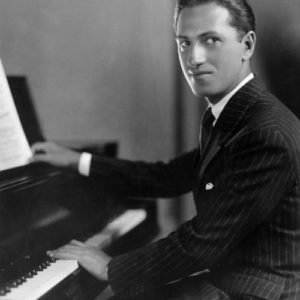 Some months ago I received an email from an exemplar of inquisitive musicianship: the pianist Kirill Gerstein, whom I had never met. (We mutually know a peerless Hungarian musical pedagogue: Ferenc Rados.)
Some months ago I received an email from an exemplar of inquisitive musicianship: the pianist Kirill Gerstein, whom I had never met. (We mutually know a peerless Hungarian musical pedagogue: Ferenc Rados.)
Gerstein had recorded a Gershwin album and wanted to know if I were interested in writing a note for it.
I was more than interested. Not only do I believe in George Gershwin; I believe we are embarking on a Gershwin Moment.
That is: modernism has departed, and so (sooner or later) will the Standard Narrative for American classical music that we learned from Aaron Copland, Virgil Thomson, and Leonard Bernstein. The Standard Narrative penalized both Gershwin and Charles Ives as gifted dilettantes. Roy Harris was the “great white hope.” No one today would put Harris ahead of Gershwin or Ives.
Commensurate with the Gershwin Moment is the demise of the high/low bifurcation of American music, which after World War I insured that American classical music would stay white. Gerstein is a classical pianist with a jazz degree (from the Berklee College of Music). Like Gershwin, he doesn’t bifurcate. In fact, his new recorded performances of Rhapsody in Blue and the Concerto in F abound with flourishes of clairvoyant improvisation.
Here’s a teaser. And here (below) is my album note:
KIRILL GERSTEIN and the GERSHWIN MOMENT
Historically, the concert music of George Gershwin has more impressed foreign-born than American-born classical musicians. And outsiders to the American experience, generally, have appreciated aspects of American music more taken for granted at home. The classic instance is Antonin Dvořák, who resided in New York City and Iowa between 1892 to 1895. The most famous and controversial of all his recorded utterances, reported in the New York Herald, prophesied that “the future music of this country must be founded upon what are called the Negro melodies.” The spirituals of the American South had struck Dvořák as an epiphany, “music that suits itself to any mood or purpose.” If Brahms had quoted Hungarian dance tunes, if Dvořák himself drew instruction from Bohemian song and dance, American composers could fashion “a great and noble school of music” by mining the African-American motherlode.
So steeped in plantation song is the plaintive Largo of Dvořák’s New World Symphony that it was turned into a beloved synthetic spiritual: “Goin’ Home.” Much less famous is the American Suite Dvořák composed a year later, in 1894; comprising a series of New World snapshots, it marks a further, ingenious appropriation of minstrel and plantation song. This was also the year of the G-flat Humoresque – music so “American” most Americans assume an American wrote it. Another Dvořák Humoresque, in F major, begins with a bluesy tune Gershwin might have composed three decades later. Serendipitously, it was the G-flat Humoresque, wafting down from Maxie Rosenzweig’s Brooklyn flat, that first inspired Gershwin to become a composer.
The immediate influence of Dvořák’s prophecy was great. It was a former Dvořák student, William Arms Fisher, who turned the Largo into “Goin’ Home.” Dvořák’s New York amanuensis, Harry Burleigh, transformed “Deep River” into a grave concert song sung the world over by Marian Anderson and Paul Robe son. Via the machinations of Burleigh and Fisher, the once celebrated black British composer Samuel Coleridge-Taylor also signed onto Dvořák’s project.
But Dvořák’s New World aspirations did not resonate with the American modernists who came next. They favored a shiny new aesthetic purged of the past. Dvořák had written of “Negro melodies”: “they are pathetic, tender, passionate, melancholy, solemn, religious, bold, merry, gay or what you will.” Aaron Copland disagreed; “From the composer’s viewpoint,” he wrote, jazz had “only two expressions: the well-known ‘blues’ mood, and the wild, abandoned, almost hysterical and grotesque mood so dear to the youth of all ages.” “Any serious composer,” he added, would quickly become aware of these “severe limitations.” Of “Mr. Gershwin’s jazz,” Copland said: “Gershwin is serious up to a point. My idea was to intensify [jazz] . . . to use it cubistically – to make it more exciting than ordinary jazz.”
And so, during his short lifetime, George Gershwin — heir to Dvořák’s prophecy — was a shunned outsider to American classical music. The influential American music narratives written by Copland and Virgil Thomson simply omitted him. America’s leading journalistic apostle of musical modernism, Paul Rosenfeld, rebuked him as a dilettante. Who today would endorse Rosenfeld’s insistence that Copland’s jazz-influenced Piano Concerto of 1927 was an improvement on Gershwin’s “hash derivative,” that Gershwin disclosed “a weakness of spirit, possibly as a consequence that the new world attracted the less stable types”?
The Gershwin threat, and the jazz threat of which it was a part, were symptoms of a youthful musical high culture borrowed from Europe – and hence obsessed with pedigree. With the singular exception of the New York Philharmonic, American orchestras for decades segregated the Rhapsody in Blue, the Concerto in F, and An American in Paris as “pops” fare. The Boston Symphony first gave these works on subscription in 1997, 2005, and 2005, respectively. The Chicago Symphony waited until 2000 for all three. The Metropolitan Opera first gave Porgy and Bess in 1985.
It was of course in the realm of popular music that Dvořák’s prophecy came true. More than in Europe, American music after World War I was bifurcated between classical and popular – a bifurcation that was also, to a degree remarkable and disturbing, a split between white and black. The Oklahoma-born Roy Harris was even called a “white hope” in the unfulfilled interwar quest for the Great American Symphony. In retrospect, what American music needed was not another Copland or Harris, but a mighty interloper to rescue American classical music from itself. But George Gershwin died at the age of 38 in 1937.
Olin Downes summarized in The New York Times: “His value may have been exaggerated… He never passed a certain point as a ‘serious’ composer.” As ever, America’s European-born conductors, composers, and instrumentalists thought differently. Otto Klemperer led his own, dirge-like transcription of Gershwin’s Second Prelude at the Hollywood Bowl Gershwin Memorial Concert. Arnold Schönberg eulogized Gershwin as “a great composer.” Jascha Heifetz, who had hoped for a Gershwin Violin Concerto, said: “We should be ashamed that we did not appreciate this man more when he was in our midst.” Other Europeans speaking up for Gershwin included Maurice Ravel and Dmitri Shostakovich – composers of great reputation with nothing to lose.
As a student at the Special Music School for gifted children in Voronezh, Russia, Kirill Gerstein was from a very early age infatuated with jazz, which he knew from his parents’ extensive record collection. At fourteen, he met Gary Burton in St. Petersburg, leading to a scholarship to study jazz piano at Boston’s Berklee College of Music. “A famous American piano pedagogue said to me, ‘Berklee??? And what would you be studying there?’ When I meekly answered ‘Jazz,’ he looked away and said, ‘I have no further questions.’” Gerstein adds: “At that time, Berklee was mainly non-classical. But in fact, some of the best classical analysis courses I’ve ever had were at Berklee. And now they’ve merged with the Boston Conservatory. They offer a comprehensive unified curriculum – from classical to jazz, Baroque to bluegrass, film music to hip-hop. Which bodes well for music education that’s stylistically fluid and unconstrained by artificial barriers.”
Berklee could only have fortified Gerstein’s mission to pursue a classical music career that would integrate his passion for spontaneous musical expression. When he performs the Schumann Piano Concerto, he does not improvise. But his reading bristles with spur-of-the-moment inspiration: a piquant voicing, a rhythmic eruption. Sonically, he works in shifting watercolors versus solidified oils. It is Gershwin’s Concerto in F, however, that becomes a full-scale playground for Gerstein’s dual schooling.
In fact, Gershwin’s legacy seems more protean than ever. No one any longer questions his pedigree. And he remains a singularly malleable and promiscuous stylist. With the exception of J. S. Bach, no other concert composer produced music susceptible to such a bewildering range of readings. Gershwin himself, overseeing the premiere of Porgy and Bess, made it very clear that John Bubbles could sing “It Ain’t Necessarily So” in his way; there was no “Gershwin way.”
The music on the present Gerstein disc is a further case in point. There does not even exist a remotely definitive edition of the Rhapsody in Blue – its instrumentation, its duration remain variable. There are two orchestrations, both by Ferde Grofé – one for the Paul Whiteman Band, the other for symphony orchestra (Gershwin afterward did his own orchestrating). Gershwin’s own two recordings, with different musical contents, are lean and driving. Oscar Levant, the pianist most closely associated with Gershwin, adopted meatier sonorities. Leonard Bernstein’s well-known reading proposed a Slavic expansiveness. It bears mentioning that Rhapsody in Blue was a 1930s sensation in Soviet Russia, and that its big tune strikingly resembles the “love theme” from Tchaikovsky’s Romeo and Juliet. The Concerto in F, historically, has been a specialty of French pianists.
All these artists, Gershwin included, played Gershwin by the book. Gerstein does not. He adds embellishments of many kinds. For the Concerto’s slow movement, he interpolates a cadenza. I asked him about all this. He said:
“The performances on the CD are culled from four consecutive concerts in St. Louis – and what I played was different every time. My intention is to strike a delicate balance – not too classical, not too jazzy. The jazzing up of Gershwin can easily be overdone. I think there is a fine proportion that’s implicit. As for the pieces themselves, I think they’re more masterly than is often perceived. In the Concerto in F, the orchestration is Stravinsky-like in its precision and transparency. This is often overlooked. And it’s even more the case for Rhapsody in Blue in the Whiteman band version that we’ve used – it’s chamber music. The more time you invest in rehearsal and refinement, the more impressive these masterpieces appear. I’ve played Rhapsody in Blue since maybe 2006. It took me some time to find my way – it’s such a volatile stylistic blend, second by second.
“There are moments where he’s alluding to jazz and interrupts to say: ’I know Rachmaninoff, I can do that. I can do Tchaikovsky, no problem.’ It’s a piece that’s naturally playful. The Concerto in F I first played in 2012. Since then, the improvised interpolations have expanded a bit. I’m not trying for ‘historical accuracy’ in interpretation. Here I’m simply responding to the stylistic threads.”
In sum: Gershwin was a premature harbinger of musical synergies we now take for granted. And American music is today verging on a Gershwin Moment long overdue. In thr world of American musicology, music historians are suddenly flocking to Gershwin in droves; a Gershwin critical edition was initiated in 2013 at the University of Michigan. In the world of American orchestras and opera companies, Gershwin is at long last a ubiquitous mainstream participant. A mere decade before Kirill Gerstein arrived in Boston, fledgling virtuosos were typically counselled not to acquire the Gershwin concerto lest it tarnish their image. No young pianist would today be so advised.
If the old Gershwin was an inspired dilettante, the new Gershwin is versatile, protean, universal. The old Gershwin was impure, in limbo, betwixt and between. The new Gershwin is wholesome, ecumenical. For Kirill Gerstein – a voracious learner — Gershwin is both a fulfillment and a beginning. What about those Dvořák Humoresques? Stay tuned.
February 11, 2018
Yannick’s Hollow Parsifal
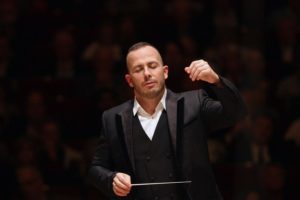
Photo by Marco Borggreve
The highwater mark for Wagner at the Metropolitan Opera in recent decades was the 2013 Parsifal, handsomely directed and strongly cast. The crucial ingredient, however, was Daniele Gatti’s leadership in the pit.
The Francois Girard’s production has now returned, led by Yannick Nezet-Seguin. As he is the company’s new music director, comparisons to Gatti are inescapable.
The Nezet-Seguin Parsifal, alas, is slack and shapeless during the opera’s long outer acts. All the virtues of Gatti’s reading – the tensile line, the depth of tone, the moment-to-moment creative investment in the drama – are missing.
Amfortas’s first act monologue, heretofore a revelation, fails to build though the singer is the same. His elevation of the grail – invested by the composer with miracles of shimmering color and texture – is inadequately prepared or supported. The brisk tempo for the ensuing chorus comes out of nowhere. The act’s closing measures, in which the orchestra must move swiftly from aching pathos to consternation to beatitude, sounds like a first try, not a finished product.
With the sound of Gatti’s act three prelude fresh in the ear – he just performed it at Carnegie Hall with his Royal Concertgebouw Orchestra – Nezet-Seguin’s rendition sounded glibly dramatic; Wagner’s intended malaise of body and spirit, conveyed by Gatti with heaving oceanic accents, was wholly absent. The Good Friday music lacked an arc. The sustained sub-current of high feeling that wonderfully anchors this particular opera, governing its mood and trajectory, remained undetectable. The long evening felt rudderless. Hollow.
Act two was much better. “This fellow needs action,” said my wife – a plausible inference. Here a wide play of tempo – including a daringly prolonged silence after Kundry’s expostulation “lachte!” – aligned with the events at hand. Evelyn Herlitzius, possessor of a monochromatic soprano of good size, vividly projected the vicissitudes of Kundry’s attempted seduction.
I wish I could be more positive about the conscientiously crafted Parsifal of Klaus Florian Vogt. He nowadays also sings Tannhauser, Lohengrin, and Walther von Stolzing in the world’s major houses – but with an instrument unlike any Wagner tenor I have previousy encountered: clear and piercing, with a vinegar timbre. Its tight focus insures audibility. The words are distinctly conveyed. But absent heft and tonal beauty, every big moment, lyric or dramatic, is squandered. My first Met Parsifal, in 1966, was Sandor Konya – today not even a name. In act two, he fell to his knees, opened his arms, and poured it on: “Erloser! Rette mich!” Thirteen years after that we had Jon Vickers: prodigious. Never since, to my knowledge, has this role been cast in New York with a voice of sufficient size.
Rene Pape and Peter Mattei repeat their assignments of five seasons ago. Pape has long and deservedly owned Gurnemanz – but the luster and stamina of his bass are now fading. Mattei’s big set pieces suffer from insufficient shaping in the pit. And, sitting in the Family Circle, I missed the revelatory facial and gestural detail he presumably still brings to Amfortas.
As it happens, for the first time in over forty years I was denied tickets by the Met press office. Whether this had anything to do with my recent posting about James Levine I have no idea. Certainly I have written more about Wagner at the Met than any other living human being. No matter, my $37 seat in row H was a bargain: the sound upstairs is superb, better than downstairs up front.
Girard’s production looks handsome from afar – but I find that I no longer tolerate his dramatization of the act one and three Preludes, or the superfluity of so many women onstage during act one. What he’s driving at is sufficiently conveyed when Kundry, rather than Parsifal, first lifts the cup at the close. I still find this interpolation exceptionally moving.
The performance (I attended Saturday night) ignited a lusty ovation that peaked when Nezet-Seguin took the stage – and suddenly ended. A response to received opinion.
Our new music director is not yet 45 year old. Whether he grows into the big Wagner works remains to be seen. But I fear that, with the disappearance of Levine, a new cult may already be upon us. Please, Tony Tommasini – not so fast.
February 7, 2018
Rethinking “Classical Radio” — Part Two
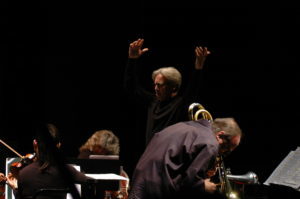
Photo by Tom Wolff
Sudip Bose, the superb music critic for The American Scholar (he is also Managing Editor), writes about PostClassical Ensemble’s radio showcase “PostClassical”:
“When I find time to listen to the radio these days, I rarely encounter a program that gives me the same sense of excitement and discovery that I felt as a child. But a few weeks ago I did, while listening to . . . PostClassical . . . Not in my wildest imaginings could I have envisioned such a revelatory and shocking interpretations.”
As mentioned previously in this space, in crafting “PostClassical,” we consciously set out to “re-invent” classical–music radio – or at least to do something uncompromising: shocking and revelatory.
Here (below) is Sudip’s whole piece, posted Feb 1.
And here’s the broadcast he heard: “Schubert Uncorked,” with bass trombonist David Taylor (pictured above in performance with PostClassical Ensemble): http://wwfm.org/post/schubert-uncorked
Doppelgangers: What does Schubert sound like on a jazzy bass trombone?
I do not listen to the radio nearly as much as I used to, but when I was growing up, programs such as Saint Paul Sunday Morning and Karl Haas’s Adventures in Good Music were household staples, forming an important part of my musical education. I began listening to Haas’s program from a very early age, and I will never forget the opening of each episode, with Haas playing a passage from Beethoven’s Pathétique Sonata before uttering those famous words—“Hello, everyone”—in his genial, warm, and sonorous voice. I must have been seven or eight, home sick from school one day, when I first heard one of Haas’s “mystery composer” programs, in which the host would play several excerpts from a composer’s work, progressing from the obscure to the more familiar, challenging the audience to guess the author’s identity. I remember that sick day well, unable, as I was, to come up with the answer. It was the first time I heard the name Camille Saint-Saëns.
Even when I do find time to listen to the radio these days, I rarely encounter a program that gives me the same sense of excitement and discovery that I felt as a child. But a few weeks ago I did, while listening to an Internet show called PostClassical, which features concert performances by PostClassical Ensemble, an innovative group of musicians now in residence at Washington’s National Cathedral. Led by the historian and writer Joseph Horowitz and the conductor Angel Gil-Ordoñez, the ensemble puts on concerts that are far from typical and often experimental, with the aim of contextualizing a composer or a piece of music with verse, theater, film, or dance. Every two months, Horowitz and Gil-Ordoñez join radio host Bill McGlaughlin (the former host of the aforementioned Saint Paul Sunday Morning) in the studio, to discuss their concerts in depth.
The show I happened to hear was devoted mainly to Franz Schubert, in particular four late songs: “Der Doppelgänger” and “Die Stadt,” from the posthumous cycle Schwanengesang, and “Nebensonnen” and “Der Leiermann,” from Die Winterreise. Yes, there were traditional renditions of these lieder, performed with feeling and great taste by the baritone William Sharp and Seth Knopp on the piano, but the versions that were juxtaposed with these—jazz-inflected variants of the pieces performed by the bass trombonist David Taylor and the instrumentalists of PostClassical Ensemble—were what captured my imagination. Not in my wildest imaginings could I have envisioned such revelatory and shocking interpretations.
These late songs of Schubert are dark, mysterious, brooding, full of despair. “Der Doppelgänger,” for example, depicts a man who has ventured to the former home of his beloved and is stunned and terrified to find his double standing there, revealed in the moonlight, staring up at the house and the sky. It’s an eerie enough work in its original setting, yet when Taylor seemingly improvised the solo line on the bass trombone, he transformed the familiar into something strange, still plangent and bewitching, but now uttered by a voice from another world—guttural, stuttering, flutter-tongued. With the orchestral accompaniment playing a steady, mesmeric dirge, the pathos was unrelenting, almost too much to bear. How had Taylor done it? I wondered. How had he conjured up a hazy, ghostly double of this moody Schubert lied? Later in the show, Taylor played “Der Doppelgänger” again, this time in a more extroverted, virtuosic manner. The same notes, but a completely different effect—the idiom more indebted to bebop and jazz, the orchestra sounding almost Brucknerian by contrast.
The title of the episode was “Schubert Uncorked,” yet this was not so much Schubert let loose as reinvented. I had never heard anything like Taylor’s version of “Nebensonnen” (about the phantom-like appearance of three suns in the sky), in which he put his trombone aside and sang the solo line instead, floating the notes in the upper register as if he were some bardic gypsy from Eastern Europe, albeit one singing in English. In “Die Stadt,” he and the ensemble managed yet another transformation, turning the fog-bound city of Schubert’s song into some dystopian landscape, the sound of the brass trombone emerging from the murky depths like some antediluvian sea creature.
“Der Leiermann” (or, “The Hurdy-Gurdy Man,” the concluding song of the cycle Die Winterreise) might seem to be an obvious candidate for this sort of imaginative metamorphosis. It’s an odd song, to say the least: at the end of his melancholy winter journey, the disconsolate wanderer-singer encounters a barefoot beggar on a street corner, shunned and reviled, playing a monotonous tune on his hurdy-gurdy. “Der Leiermann” has reminded the tenor Ian Bostridge of Bob Dylan. It’s a song, according to Bostridge, “that doesn’t conform to classical norms in singing,” one in which “it is hard to achieve the requisite vibe.” Indeed, when Bostridge was performing Die Winterreise once in Russia, “Der Leiermann” “emerged as a song that was hardly sung, rasping and guttural by the standards of bel canto.” His fear was that it would sound “like a ridiculous intrusion of pop singing into the classical world.” How appropriate, then, given this context, was Taylor’s version, both played and sung (the vocal line at times approximating the half-spoken half-sung technique known as Sprechstimme), with Zoltan Racz accompanying him on the accordion. It was a polystylistic marvel—reminiscent of jazz, folk music, Indian ragas—and almost symphonic in the density and conflation of textures, styles, and timbres. The two-hour episode held other delights: a hair-raising rescoring of Schubert’s Arpeggione Sonata, a moving version of the Adagio from Bruckner’s String Quintet, and two movements of the Bass Trombone Concerto by the Swiss composer and saxophonist Daniel Schnyder—kinetic, driven, seductive in its use of Middle Eastern idioms—yet it’s Taylor’s Schubert performances that have been haunting me ever since. I cannot get them out of my mind.
To listen to “Schubert Uncorked” and other episodes of PostClassical, visit http://wwfm.org/programs/postclassical#stream/0. To learn more about PostClassical Ensemble, go to http://postclassical.com/.
February 3, 2018
Another Cheap Shot at Wagner
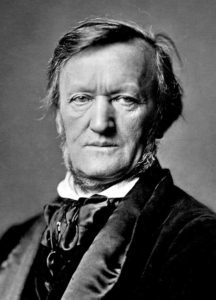 Was Richard Wagner a “monster”? No so far as I can tell. Here’s my book review of Simon Callow’s opportunistic “Being Wagner” in this weekend’s “Wall Street Journal”:
Was Richard Wagner a “monster”? No so far as I can tell. Here’s my book review of Simon Callow’s opportunistic “Being Wagner” in this weekend’s “Wall Street Journal”:
In 1866, a Munich newspaper reported that Minna Wagner, the recently deceased wife of the composer Richard Wagner, had lived in “direst penury.” She was reduced to accepting poor relief notwithstanding “momentary” support “on the part of her [estranged] husband.” Never mind that a letter signed by Minna herself had stated that the voluntary annual allowance she received from her husband had permanently freed her from financial cares. The newspaper claimed— falsely—that the letter had been written for her in order to conceal the facts.
This instance of fake news was not a novel occurrence in Wagner’s harried life. And 135 years after his death he is harried still by the mandatory cartoon that makes him a “monster.”
There are three basic sources for depicting Wagner the man. First there are his operas, which remain as vital to the Western cultural canon as ever. Second there is his personal behavior, copiously recorded in letters and other written accounts. Third there are his essays, notoriously including the egregiously anti-Semitic “Judaism in Music” of 1850. Though any portrait of Wagner that begins with the essays will necessarily be prejudiced against him, this is a typical route. There are even influential writers on Wagner who disdain considering the operas altogether.
As it happens, the operas are saturated with complex self-portraiture, and a governing motif is Mitleid—compassion. Like it or not, Wagner’s characters specialize in empathetic comprehension. And any perusal of Wagner’s more than 12,000 letters will confirm that this humane aptitude was not foreign to Wagner the man. His many heart-breaking letters to Minna document astute, guilt-ridden understanding of their failed marriage, an understanding that impelled him to generously support an unhappy and unpleasant woman even when his own financial resources were nearly barren.
And Wagner was uncommonly rich in friendships. According to the monster cartoon, these friendships were all fundamentally exploitative. But consider the impresario Angelo Neumann, who left a book-length account of his eventful personal and professional relationship with the composer. Why was Neumann so dedicated to Wagner? Because he recognized his genius. Because Wagner’s prickly company was galvanizing. And because Wagner’s torrent of human feeling was endearing. Neumann, by the way, was Jewish.
The Wagner literature disposes of Neumann, Hermann Levi and other Jews in the Wagner orbit as studies in self-hatred. Such an approach is patronizing and obtuse. A fairer question is why Wagner wrote and spoke such intolerable nonsense about Jews. Reasons of a sort may be adduced. But the simple fact is that his evil anti-Semitism does not align with his actual behavior. That behavior is often elusive because Wagner was a consummate actor. He wore many faces. Was he a master imposter, or was he (as his letters suggest) helplessly inhabited by a repertoire of demonic personae?
That the actor and author Simon Callow should be enticed by such a figure is only natural. His own distinguished career includes one-man shows aimed at illuminating Jesus, Shakespeare, Dickens, Oscar Wilde—and Wagner. He has now turned his Wagner performance into a reckless little book that stylishly recycles the standard monster caricature.
In “Being Wagner,” Mr. Callow writes early on that his main source was the composer’s “own words, in his copious published writings. . . . Above all, I found that my most sustained sense of the man came from a book I had somewhat dreaded reading—his two-volume autobiography, My Life.” Mr. Callow’s surprise that the book “turned out to be as vivacious and candid as the greatest artists’ autobiographies” says it all. Everything endearing about Wagner—including the “surprisingly punctilious” pension he paid to Minna—strikes Mr. Callow as uncharacteristic. He is himself a victim of the monster myth, which he inserts as a corrective whenever his Wagner portrait turns too pleasant.
In particular, Mr. Callow is seduced by the ironic panache of Wagner’s self-descriptions, the most memorable of which are nearly Dostoyevskian exercises in hilarious self-humiliation. Mr. Callow’s compression of these stories—their merciless expansiveness is itself comedic—does not do them justice. A greater injustice is that the derisive tone Wagner applies to himself turns patronizing when applied to Wagner by another, lesser writer.
That Mr. Callow’s breezy portrait of Wagner is disrespectful will not be noticed by readers brainwashed by the monster cartoon. A small minority will think twice and recognize that Mr. Callow is glibly passing judgment on a supreme psychologist whose distressing and self-distressing gift was to peer more profoundly into the human psyche than any of his contemporaries—a predicament that left him lonely, restless and insatiable.
The first singer to portray Tristan was Ludwig Schnorr von Carolsfeld, a prodigious artist whom Wagner regarded as a rare friend. He died suddenly, age 29, days after the premiere. Wagner confided to his diary: “I drove you to the abyss! I was used to standing there: my head does not swim. But I cannot see anyone else standing on the brink: that fills me with frantic sympathy.” Anyone who thinks those words are hyperbolic does not know the existential void into which Tristan plunges.
Central to Wagner’s identity was his unwavering recognition of the magnitude of his genius and the conditions for its proper cultivation. He was convinced that the world owed him a living. If he were to pursue conducting, or some other gainful employment, he could not compose. As a result, he was frequently impoverished and ill, vilified and derided. His enemies were real, powerful and numerous. Mr. Callow here discovers “a beady instinct for protecting his gift, his genius, and what fed it.” He argues that when Wagner “sued for favours, he had two modes: one, grovelling, the other haughty.” Wagner was himself the keenest analyst of his extreme instability. “What makes you see or wish to see a wise man in me? How can I be a wise man, I who am myself only when in a state of raving frenzy?” Mr. Callow cites this frank testimony to an intimate correspondent only to discover evidence of “the unrelenting soap opera” of Wagner’s “emotional life.”
Even in a book eschewing musical analysis, Mr. Callow is betrayed by his ignorance of music. Did Wagner retouch Beethoven’s orchestration because “Beethoven had, in Wagner’s view, got it wrong”? No, like many conductors afterward, he felt the need to accommodate changes in instruments since Beethoven’s day. Did he create “the notion of the conductor as puppet master”? No, as he explained in his pamphlet “On Conducting,” Wagner realized that a new kind of music—marshaling larger forces and pervasively flexing tempo and dynamics—required a new kind of proactive conductor. Did the tenor Albert Niemann trim the role of Tannhäuser because he figured “the sooner the inevitable catastrophe was over, the better”? No, Niemann (a supreme singing actor) felt that he could not sustain the opera’s last act without abridging the second-act finale.
As for “Tannhäuser” itself, did it arise from “the compost heap” of Wagner’s imagination? Is “Die Meistersinger” “everything Wagner said an opera shouldn’t be”? Does the “Ring of the Nibelung” amount to “self-celebrating Teutonic tub-thumping”? Come on. Summarizing the affect of it all, Mr. Callow says that Wagner’s audiences are impelled toward mass submission, not the state of active critical engagement provoked by Bertolt Brecht. Is he actually not aware that the “Ring” and “Tristan” have excited more intense critical commentary than the fading Brechtian corpus ever will?
The closest Mr. Callow comes to plausibly evoking Wagner the man is when he quotes those who admired him. Here, for instance, is the dramatist Édouard Schuré: “To look at him was to see turn by turn in the same visage the front face of Faust and the profile of Mephistopheles . . . one stood dazzled before that exuberant and protean nature, ardent, personal, excessive in everything, yet marvellously equilibrated by the predominance of a devouring intellect.” And here, balancing the books, is Mr. Callow’s follow-up: “Wagner had, it seemed, no inhibitions whatever, his qualities and defects on open display, to the delight of some and the deep repugnance of others.”
Predictably, Mr. Callow more extensively considers “Judaism in Music” than any of the operas. He blithely clinches the Wagner-equals-the-Third Reich equation: “Hitler-like,” Wagner spewed poison—“the notion of the Jews as a rotten part of the body politic which needed to be excised”—that was “enthusiastically taken up by the Nazis.” In fact, whether a straight line runs from Wagner’s brand of odious anti-Semitism to Hitler’s murderous Judenpolitik is a necessary question long debated by historians, with no consensus in sight.
It is wholly understandable that the shadow of the Holocaust has for more than half a century blackened our view of Wagner the man. Someday a revisionist wave will surface. But not yet.
Mr. Horowitz’s books include “Wagner Nights: An American History.” His book-in-progress is “Understanding Wagner.”
January 19, 2018
Exalting Bruckner at Carnegie Hall
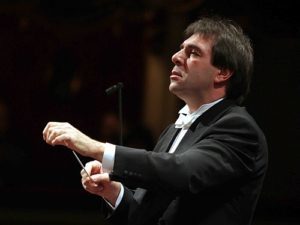 Bruckner’s symphonies are communal rites of spiritual passage. For maximum impact, they require a proper hall and appropriate congregants. In New York City, Lincoln Center’s Geffen Hall – formerly Fisher Hall, and Philharmonic Hall before that — is too dry and plain for Bruckner, and the New York Philharmonic audience that habituates that troubled space is restless and irreverent. I’ve heard Lincoln Center Bruckner conducted by Leonard Bernstein, Christoph Eschenbach, Kurt Masur, Riccardo Muti, and Klaus Tennstedt. None of these experiences stuck except Tennstedt’s Symphony No. 8, a volcano of existential intensity. But lacking the requisite cathedral sonority.
Bruckner’s symphonies are communal rites of spiritual passage. For maximum impact, they require a proper hall and appropriate congregants. In New York City, Lincoln Center’s Geffen Hall – formerly Fisher Hall, and Philharmonic Hall before that — is too dry and plain for Bruckner, and the New York Philharmonic audience that habituates that troubled space is restless and irreverent. I’ve heard Lincoln Center Bruckner conducted by Leonard Bernstein, Christoph Eschenbach, Kurt Masur, Riccardo Muti, and Klaus Tennstedt. None of these experiences stuck except Tennstedt’s Symphony No. 8, a volcano of existential intensity. But lacking the requisite cathedral sonority.
Carnegie Hall, a few blocks downtown, is ideal for Bruckner, and I’ve heard a lot of it there. The conductors were Claudio Abbado, Daniel Barenboim, Herbert Blomstedt, Sergiu Celibidache, Bernard Haitinck, Eugen Jochum, Masur again, Zubin Mehta, Simon Rattle, and Wolfgang Sawallisch. The performances that mattered were Celibidache in No. 4 and Jochum in No. 8. For Celibidache I smoked a joint and sat up close and I knew what I was doing – the symphony played itself in slow motion, with every detail of sonority and balance hypnotically poised. Jochum’s Eighth was, by comparison, warmly human, therapeutically wholesome, rapturously beautiful.
Daniele Gatti, who conducted the Royal Concertgebouw Orchestra in Bruckner’s Ninth Symphony a few nights ago at Carnegie Hall, is relatively new to me. I first heard him five seasons ago at the Metropolitan Opera, conducting Parsifal – a performance I reviewed in the Times Literary Supplement and reprinted here. Gatti’s Parsifal was the most memorably conducted opera I’ve encountered in New York in decades. His Carnegie Hall program – which began with excerpts from Parsifal act three – confirmed that first impression.
What distinguishes this conductor, so far as I can tell, is a combination of German and Italian traits that reads like a string of clichés. German is his mastery of structure and – a related attribute – inspired access to the harmonic undertow of tension and release that grounds “Innerlichkeit.” The Italian part is what makes Gatti’s Bruckner sui generis: a Mediterranean investment in legato and sostenuto. Long, sinuous strands of song are wedded to long-range musical architecture. With the Concertgebouw, the weight and suppleness of these sound designs were – even more than at the Met – singularly refulgent. The Gatti Bruckner 9 was distinctive, vast, exalted. A great performance.
So sustained was Gatti’s architectural plan that – unique in my experience of the work – he launched the second movement attacca, without so much as an exhalation of breath following the first movement’s massive coda. The symphony’s ending, often fashioned as a celestial appendix, was in Gatti’s reading not a narrative event, but structural: the beatific halo was not distended.
Bruckner’s Ninth is full of pregnant silences. Gatti’s were in some cases daringly prolonged, but at all times precisely calibrated to weigh a phased accretion or dissipation of pulse and intensity. In these fraught passages, the audience plays a crucial role. At Carnegie, 2,500 listeners sat silently in thrall: a welcome sign of civilization.
I left the hall feeling wonderfully purged. How I wish that New York City had a conductor or orchestra of such exalted caliber.
January 16, 2018
America’s Most Exceptional Orchestra
Setting aside PostClassical Ensemble, the guerilla DC chamber orchestra I co-founded fourteen years ago, the most exceptional American orchestra I know is the South Dakota Symphony.
South Dakota’s “Copland and Mexico” festival, which concluded last Sunday afternoon, had many highlights. The performance of Silvestre Revueltas’s Sensemaya was lots better than the versions you can see on youtube conducted by Gustavo Dudamel. The crucial difference was a slightly slower tempo, maximizing the weight and momentum of this amazing Mexican juggernaut, and the expert punctuation of certain rhythmic details at the very end. The musicians, for whom Revueltas was a discovery, responded with an infectious gratitude and excitement I do not typically encounter elsewhere.
Another new work for the orchestra as Aaron Copand’s prize-winning 1934 Communist workers’ song, “Into the Street May First!” It was to have been sung by a local chorus. When that fell through, the musicians took it over with interest and alacrity, singing from their seats. (A few scurrilously threatened to “take a knee.”)
Only a veteran of American symphonic affairs could fully appreciate the South Dakota situation. Many orchestras are fractured by tensions between “labor” and “management.” Wariness and indifference are pervasive. When the Pittsburgh Symphony went on strike in 2016, the picketing players were quick to differentiate themselves from the institution. That would be unthinkable in Sioux Falls.
The crucial ingredient is the 57-year-old music director: Delta David Gier. A year into his tenure, he moved to Sioux Falls. He and his wife have raised their kids there. What he has achieved would have been unthinkable had he not decided to become a local resident. That many American music directors live off site is tolerated far more than it should be. Art museums aren’t run by outsiders. Neither are theater companies.
Gier’s South Dakota programing is sophisticated. He emphasizes new and American works. Next season’s Mahler 8 will complete a comprehensive South Dakota Mahler cycle. He does without guest conductors and brand-name soloists. His 14-year tenure shows what can happen, over time, when a music director with vision is manning the home front.
The orchestra’s signature initiative is the Lakota Music Project, which Gier initiated in 2009. It connects SDSO to six Indian reservations. The relationship is symbiotic; it builds trust and community. To date, SDSO has produced more than 30 side-by-side musical events juxtaposing two cultures and their practitioners.
Two seasons ago, SDSO travelled to the Lake Traverse Indian Reservation to perform “Dvorak’s America,” exploring the influence of Longfellow’s The Song of Hiawatha on Dvorak’s New World Symphony. I reported the outcome in this space. The mood on the bus was cheerful: business as usual. Many another orchestra would have resented that three-hour ride.
Last week’s “Copland and Mexico” was partly undertaken as an overture to Sioux Falls’ Hispanic community. The Church of Our Lady of Guadalupe was a center of attention. So were two middle school classes that spent two months studying aspects of Mexican culture and history. The students’ “infographics” were displayed in the lobbies of the Washington Pavilion performing arts center. Six middle schoolers took part in pre-concert discussions with Gier. More than 500 newcomers to SDSO attended the festival concerts for free. The hall was packed with families.
The contract SDSO has negotiated with its players promotes a degree of “service flexibility” that could be controversial elsewhere. It maximizes opportunities to send musicians to schools, hospitals, health centers — and Indian reservations. The musicians feel well utilized. They interact as a family.
Both “Dvorak and America” and “Copland and Mexico” came to Sioux Falls via the NEH-funded Music Unwound consortium that I am fortunate to direct. SDSO is the ideal recipient. Both prongs of Music Unwound – contextualized, cross-disciplinary programs, and linkage to institutions of education – are fully served.
“Copland and Mexico” tells the story of Aaron Copland’s 1930s Mexican epiphany. The examples of Diego Rivera and Carlos Chavez turned him into a populist – even, for a time, a political artist on the far left. We heard Copland’s El Salon Mexico. Mainly, however, the program introduced a lesser-known musical genius surpassing Copland: the mercurial, short-lived Revueltas. The main event was a film with live music: Redes (1935), in which Paul Strand’s hypnotic cinematography and Revueltas’s volatile score mark one of the highest and most dialectical achievements in marrying music with the moving image.
It was Gier’s inspiration to rupture the concert with a surprise. Not only did “Into the Streets, May First!” interrupt the scripted narration; it was instantly followed by a re-enactment of Copland’s testimony when in 1953 he was subpoenaed by Joe McCarthy and asked if he had ever been a Communist. Bob Wendland, playing Copland, stood in a solitary spotlight; McCarthy’s voice of god was declaimed from on high. As with so many American artists and intellectuals, Copland’s Depression-era politicization returned to haunt him during the Red Scare.
The SDSO concerts incorporated vigorous 45-minute post-concert discussions. On Saturday night, an audience member asked how the musicians felt about accompanying a film. Mario Chiarello, one of three members of the double bass section who teaches music in Sioux Falls public schools, had joined the post-concert audience – and volunteered a response. He explained that Redes was twice rehearsed without the film. With the addition of the film at the dress rehearsal, he said, a new dimension was attained. The musicians could not see the overhead screen, but an uncanny sensation swept the orchestra – a feeling of being empowered by “something bigger.”
That could stand as a metaphor for the South Dakota Symphony Orchestra.
December 22, 2017
The Case of James Levine: Taking Stock
When a pianist plays the piano, when a violinist plays the violin, when a conductor conducts an orchestra, the performer channels music through a network of personal traits. This should be self-evident.
It has always seemed to me, for instance, that Artur Rubinstein was an exceptionally wholesome artist. Listen to Rubinstein’s recordings of Chopin waltzes and you will discover (however subliminally) a broad emotional vocabulary at play – and a conscious application of specific emotional states to specific waltzes. The entire exercise is one of cultivated civility and worldly maturity. We are sampling the performer’s persona.
I have two favorite studio recordings of Schubert’s “Great” C major Symphony: Wilhelm Furtwangler with the Berlin Philharmonic and Josef Krips with the London Symphony. Back in the days when such things mattered, these were known readings. (As a young New York Times music critic, I once wrote an assessment of the Furtwangler performance. A reader wrote to state his preference for Krips, and explained why.)
Furtwangler’s Schubert C major is epic and demonic. Krips’s is warm and songful. In affect, these readings have little in common. They both deeply engage with the scope and pathos of a score that – as so often in Schubert – is uncannily polyvalent.
It is easy to trace the lineage of these readings. Furtwangler’s feasts on Germanic Innerlichkeit, and also precepts of interpretation preached by Richard Wagner. A constant flux of tempo calibrates flow, structure, and climax. Krips’s interpretation extols Viennese gemutlichkeit; Furtwanglerian interventions, in such a context, could only get in the way.
James Levine’s high reputation as a musical interpreter has always seemed to me a frustrating mystery. Whether of Verdi or Wagner, his performances evinced no lineage. And his persona, so far as I could tell, remained a blank.
When he first arrived at the Met, he whipped the orchestra and chorus into shape and refreshed the repertoire. No doubt he was a facile musician. Even as a young man, he had evidently acquired a lot of repertoire and practical experience. His readings were typically intense, massive, and loud, sometimes to the point of brashness. In subsequent decades, he mellowed. But I never heard from Levine much evidence of emotional variety or depth. According to my experience, he had little capacity to organize a long stretch of music, or to powerfully shape a climax or pregnant phrase. He did not produce a sonic signature – as Furtwangler and Krips did; as Gergiev and Muti do. He did not possess an ear for color or texture.
If you listen to the Met broadcasts of Ettore Panizza and Artur Bodanzky – broadcasts I have written about in this space – you’ll hear conducting (and orchestra playing) of a higher caliber. And Panizza and Bodanzky stood on the shoulders of giants: Seidl, Mahler, Toscanini. The early Met was a conductor’s house.
Let me share a couple of vignettes.
In the 1980s I was artistic advisor to the Schubertiade at the 92nd Street Y. The central participant was the baritone Hermann Prey, invariably partnered by Leonard Hokanson. Hokanson had studied with Artur Schnabel. His Lieder accompaniments were highly shaped, highly inflected interpretations; I would call them “Schubertian” a la Schnabel. He and Prey worked seamlessly together. Then it happened that Prey was offered a Carnegie Hall recital, singing Schubert. He replaced Hokanson with James Levine. Levine and Prey also worked seamlessly together. But Levine’s accompaniments, next to Hokanson’s, were stiff and generic. The performances were forgettable.
A little before that, when I was a critic for the Times, I hung out at the home of a psychoanalyst who would rent an extra bedroom. His tenant, for a period of time, was a young man from within James Levine’s inner circle. I was recklessly frank in sharing my poor opinion of Levine’s performances. On one occasion, I suggested that Levine (then in his thirties) lacked sufficient life experience to conduct opera at the highest level. Opera is theater, after all. You don’t entrust Hamlet to someone who doesn’t know life. His quick response told me that this question had been asked and answered before – the answer being that breadth of “life experience” wasn’t a valid consideration in the world of classical music performance.
I shared these views the other day with a member of the Met orchestra. He contrasted James Levine with conductors who command a “complete” concept of an opera. He mentioned Carlos Kleiber and Daniele Gatti. My Times Literary Supplement review of Gatti’s Parsifal appeared in this space; it made the Levine Parsifal sound square and cumbersome. I did not hear Kleiber’s Rosenkavalier at the Met. My friend remembers Kleiber instructing the orchestra that the music accompanying the Marschalin must shimmer like chiffon, creating a veil through which this character’s fading beauty could be apprehended.
On youtube you can watch Kleiber rehearse the overture to Die Fledermaus — a supremely worldly operetta. After three notes of the first, teasing theme in the violins, he stops the orchestra to ask for a rendering “a little more dishonest.”
There is a ripeness in that exhortation that my ears never detected in the performances of James Levine.
December 17, 2017
Schubert Uncorked
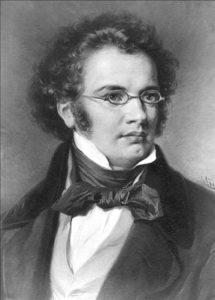 Every once in a while a master composer creates music so radically new that it seemingly falls wholly outside its time and place. Franz Schubert’s 1828 song cycle Winterreise (“Winter’s Journey”), charting an uncanny descent into madness, is such a work. Schubert’s contemporaries didn’t know what to make of it. Its chilly existential numbness is routinely likened in affect to Dostoyevsky. But Winterreise is sui generis.
Every once in a while a master composer creates music so radically new that it seemingly falls wholly outside its time and place. Franz Schubert’s 1828 song cycle Winterreise (“Winter’s Journey”), charting an uncanny descent into madness, is such a work. Schubert’s contemporaries didn’t know what to make of it. Its chilly existential numbness is routinely likened in affect to Dostoyevsky. But Winterreise is sui generis.
The timelessness of Winterreise, its limitless expressive parameters, tantalize singers to do something more. It has sometimes been staged. In my experience, adding something more to Winterreise results in something less. I know of only one exception: the Schubert excursions of the bass trombonist David Taylor, himself sui generis.
Taylor plays and sings Die Nebensonnen and Der Leiermann – the final two songs of Schubert’s cycle. He also plays two late Schubert songs setting bleakly surreal poems by Heinrich Heine: Die Stadt and Der Doppelganger.
Der Doppelganger has in fact become a Taylor signature. He first performed it many years ago in Vienna’s Musikverein, as an encore with the Tonkunstler Orchestra. Taylor remembers the initial skepticism of the musicians – and also their subsequent amazement, and that of Vienna’s music critics. He tells this story as part of “Schubert Uncorked,” the latest installment of PostClassical Ensemble’s “PostClassical” radio series on the WWFM Network.
You can hear Taylor tell this story on part two of “Schubert Uncorked.” If you want a mighty dose of Taylor’s Schubert, listen to Die Stadt and Der Doppelganger on part two, beginning at 32:53.
These unique radio programs are recorded in real time by myself, Angel Gil-Ordonez, and Bill McGlaughlin. We listen and react. Bill is in charge. He brings to this assignment a singular combination of gravitas, humor, and informed sincerity. Hearing Taylor’s Schubert for the first time, he registered incredulous admiration; he called Taylor’s Nebensonnen “naked in front of the world.” Angel, re-hearing Schubert/Taylor performances he had conducted half a dozen years ago, called them “much more emotional” than the original versions: “This level of sentiment cannot be achieved with a [singing] voice.” My own reaction, on the air, was to call Taylor’s Doppelganger an inspired “phantasmagoria.” If you think all this is hyperbolic, listen to the broadcast and think again.
Like all PostClassical broadcasts , “Schubert Uncorked” features performances by Gil-Ordonez conducting PostClassical Ensemble – in this case, culled from two different concerts. The first of these juxtaposed Taylor’s readings with the songs as Schubert composed them, rendered by the baritone William Sharp (whom I would call today’s supreme American singer of concert songs).
“Schubert Uncorked” also includes the broadcast premiere of the Schubert/Taylor Arpeggione Concerto, which recasts Schubert’s virtuosic Arpeggione Sonata as a wild showcase for bass trombone and strings. You can hear Taylor, in the broadcast, confessing about this premiere performance: “I was afraid, actually.” We all were.
Taylor also said, of his Doppelganger at 37:45 of part two: “I don’t’ recognize my own playing . . . I never played it like that. That was pretty gargantuan.” And so it is.
You can also hear Taylor playing Daniel Schnyder’s Bass Trombone Concerto, composed for Taylor in 1999. It’s now played by trombonists all over the world. Schnyder is a master synthesizer of jazz and classical styles. His gift for orchestration and instrumentation sets him completely apart from others who produce pabulum when mixing genres and traditions. The PCE performance is a kaleidoscopic romp – you won’t find any youtube performances of the Schnyder concerto this vividly realized.
PostClassical broadcasts are two hours long. We take no prisoners. We trust our listeners. There is plenty of talking, including spats and harangues. My gratitude to David Osenberg of WWFM, who proposed PostClassical and is our producer, is profound.
P.S.: PostClassical Ensemble is about to commission from Daniel Schnyder a Mahler appropriation: “Wenn mein Schatz Hochzeit macht” for bass trombone (Taylor), baritone (Sharp), and Chamber Orchestra.
Here’s a listener’s guide (below) for “Schubert Uncorked.” The full broadcast may be accessed here.
PART ONE:
9:01: Schubert: Der Doppelganger (William Sharp, baritone; Seth Knopp, piano)
*13:01: Schubert/Taylor: Der Doppelganger (David Taylor, bass trombone; PCE conducted by Angel Gil-Ordonez
23:06: Schubert: Nebensonnen (William Sharp, baritone; Seth Knopp, piano)
*25:56: Schubert/Taylor: Nebensonnen
31:12: Schubert: Der Leiermann (William Sharp, baritone; Seth Knopp, piano)
*34:22: Schubert/Taylor: Der Leiermann (Taylor; Zoltan Racz, accordian)
*44:13: Schubert/Taylor: Arpeggione Concerto (ending) (Taylor, PCE, Gil-Ordonez)
PART TWO:
*00:00: Schubert/Taylor: Arpeggione Concerto (mvmt 2) (Taylor, PCE, Gil-Ordonez)
14:03: Bruckner: Adagio from String Quintet (arr. for string orchestra) (PCE, Gil-Ordonez)
*32:53: Schubert/Taylor: Die Stadt (Taylor, PCE, Gil-Ordonez)
37:45: Schubert/Taylor: Der Doppelganger (Taylor, PCE, Gil-Ordonez)/
54:33: Schnyder, Bass Trombone Concerto (mvmt 2) (Taylor PCE, Gil-Ordonez)
1:01:00: Schnyder: Bass Trombone Concerto (mvmt 3) (Taylor, PCE, Gil-Ordonez)
*Broadcast premiere
Joseph Horowitz's Blog
- Joseph Horowitz's profile
- 17 followers


